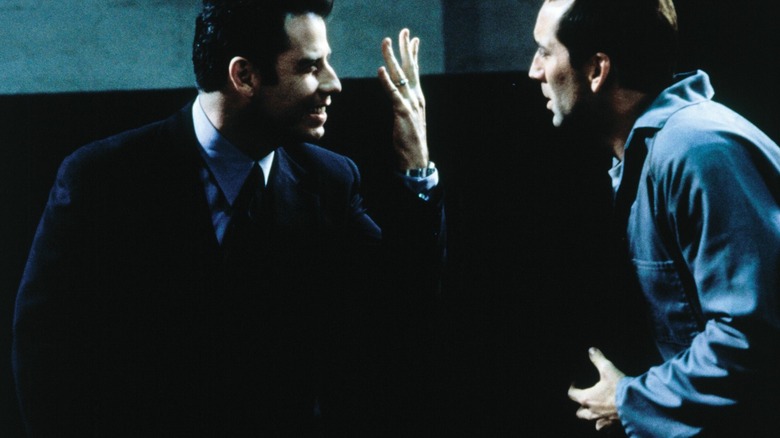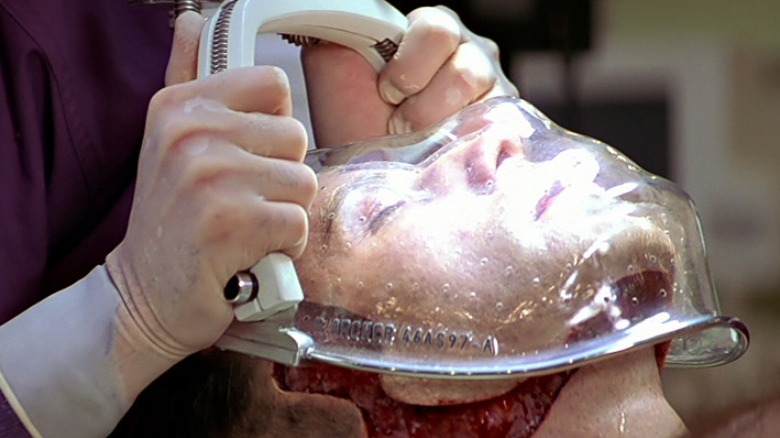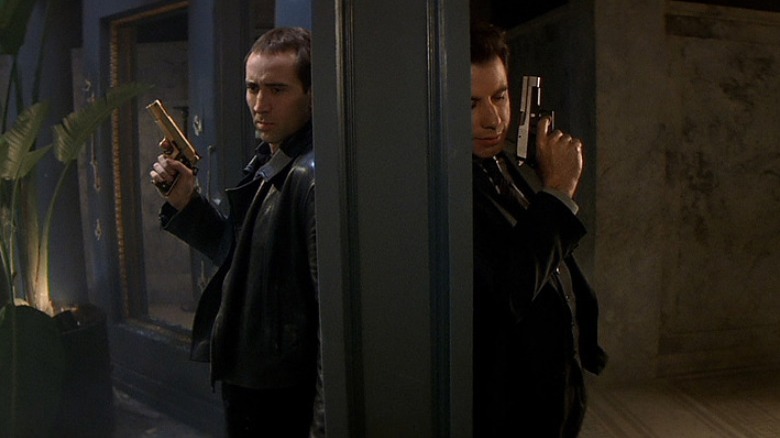How Face/Off Pulled Off That Famous Transplant Scene
John Woo's "Face/Off" has been cemented into popular culture due to a plethora of reasons, be it the powerhouse, all-in performances by the leads, an implausible, yet fun central premise, or simply the idea of John Travolta and Nicolas Cage swapping faces. The face transplant scene in "Face/Off" forms the crux of the narrative, as it allows the characters to slip into the shoes of another, and the results are both hilarious and terrifying.
As a quick refresher, "Face/Off” follows government agent Sean Archer (Travolta) and eccentric criminal Castor Troy (Cage), who share a mutual hatred, exacerbated after Troy accidentally kills Archer's son during an assassination attempt. While Archer is hell-bent on retribution, Troy continues to do what he does — sowing seeds of terror for kicks (and money) — having planted a bomb somewhere in Los Angeles with a multi-day ticking timer.
In order to get to the bottom of this, Archer must do something absurd and borderline bonkers: he must undergo experimental surgery and wear Troy's face to trick the terrorist's brother Pollux, who's in prison, to identify the bomb's location. This leads to the famous transplant scene in the film, in which Archer's face is surgically removed and replaced by Troy's, which is really trippy to witness. The practicality of the premise aside, how was this sequence pulled off? The creative process behind this scene is painstaking and meticulous, deserving more credit than it is usually granted within the ambit of an off-the-rails, John Woo action flick.
Manually-controlled life-like clones
A behind-the-scenes video for the making of "Face/Off" outlined the thorough artistic process that was put in place in order to pull off the illusion of the actors undergoing reconstructive surgery. To help make the absurd premise more believable, the creators brought in special effects artist Kevin Yagher, who is best known for crafting Freddy Krueger's makeup in "Freddy's Nightmares" and "A Nightmare on Elm Street 4: The Dream Master," and bringing the Chucky doll to life in 1988's "Child's Play." Yagher went on to create two life-like, full body clones of Cage and Travolta, which resembled their real bodies "right down to the pores," which could breathe and twitch as a real human body would (an effect achieved via manual remote control).
In the video, Cage comments on the life-size cast of his own body used in the face transplant scene, dubbing the experience as trippy and "terrifying":
"They made a clone of me, which is terrifying to look at. You could trip out on it. It breathes and it twitches its face — and it's amazing."
Yagher explains that after the casts of the actors were created, they were remodeled using silicone rubber, with the team referencing detailed photographs to recreate bodily features unique to Cage and Travolta. This proved to be an arduous process, as hundreds of individual (fake) hair strands were stitched onto the bodies to make them appear lifelike. This works to an extent — although one would have no idea about the actual lengths to which the special effects team went to pull this off, based on the scene in the film alone.
Apart from this, servo motors were attached to the clone face to mimic facial tics and movements, which were radio controlled via transmitters. This is actually pretty cool to witness, given the sheer amount of work that went into achieving this brief, yet pivotal scene.
To wear the face of another
The face swap scene, of course, does not adhere to real-life plausibility from a medical or scientific point-of-view. It is not meant to, as the entire premise of the film hinges on a willing suspension of disbelief. The movie works best on the level of enjoying a fast-paced action piece with insane shootouts, with Cage and Travolta displaying their range via the switched identity plotpoint — with both portraying two vastly different personalities in the same movie.
Archer's plan to wear the face of his son's killer is a morally complex one: on the one hand, he does not wish to assume the identity of an unhinged, remorseless killer, but he must, if he wishes to save the lives of thousands by defusing a ticking time bomb. When Archer-as-Troy is stuck with the face of a killer after Troy wears Archer's face and plays secretly-diabolical-public-hero, "Face/Off" reaches heights within the action genre quite uncharacteristic at that point in time.
To see Cage switching from hilariously headbanging in a priest outfit to playing a pained, torn Archer who wishes to convince the world of his truth is nothing short of unforgettable, cemented by scenes in which he must pretend to be Troy while retaining his innate humanity. On the flip-side, Travolta must shed his Archer-persona and embrace the chaotic madness of Troy, manifested in the scenes in which he leers over Archer's wife Eve and daughter, Jamie. These scenes are uncomfortable to watch, given the gap in knowledge between the audience and the oblivious characters, which helps heighten the tension during confrontations, and the final, over-the-top, bombastic fight scene that simply takes the cake.
In the end, it all works out for the best: the faces are swapped back to their rightful owners, and the film ends on a (dubiously) happy note, with Archer bringing Troy's son home and raising him as their own. With a "Face/Off" sequel tentatively in the works with Adam Wingward attached to the project at the moment, it remains to be seen where the story goes next, and whether we will witness another face/off that eclipses the bonkers original.


